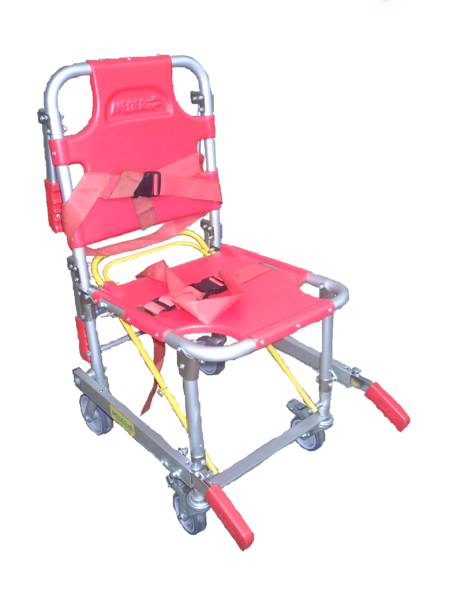Evacuation chair
Contents |
[edit] Introduction
Building evacuation is the process of making sure everyone inside a building gets out safely and in a timely and controlled manner in the event of an emergency, such as a fire. Buildings commonly use equipment such as fire alarms, exit signage, emergency lighting and emergency escape routes to facilitate evacuations.
Multi-storey buildings may also be equipped with evacuation chairs (also known as escape chairs, disabled evacuation chairs, stairway evacuation chairs, fire evacuation chairs or evac chairs) strategically located in protected areas such as corridors or stairways. These devices can be used to assist people with limited mobility (due to an injury, mental health condition, pregnancy or other physical condition) so they can use the stairwell and exit the building safely.
[edit] What is an evacuation chair?
An evacuation chair is a lightweight device that can assist a person with limited mobility to use a stairway. The device is meant to be operated by one person and should require minimal training. It is designed to reduce the amount of heavy lifting that could be required in the event of an evacuation.
Evacuation chairs move at a controlled speed down a portable ramp or track to transport the person to the ground. Some chairs are motorised while others are manually transported.
[edit] Legal requirements
The Regulatory Reform (Fire Safety) Order 2005 (RRFSO) states that it is up to the 'responsible person' (the person in control of the building) to provide a fire safety risk assessment. This assessment should include an emergency evacuation plan along with any evacuation chair requirements.
The assessment should be designed for all people (including those with special mobility requirements - such as visitors) who are likely to be on the premises. This is particularly important in public buildings, healthcare facilities, schools, care homes and other structures that support people with disabilities. In these types of facilities, it is up to the responsible person to make sure the evacuation chairs are in place and in proper working order.
[edit] Related articles on Designing Buildings
- Building evacuation.
- Chair.
- Evacuating vulnerable and dependent people from buildings in an emergency FB 52.
- Protected escape route.
- Protected stairway.
- Responsible person.
- Risk assessment under The Regulatory Reform (Fire Safety) Order 2005.
- The need for company fire risk assessments.
- The Regulatory Reform (Fire Safety) Order 2005.
- Wheelchair user.
Featured articles and news
RTPI leader to become new CIOB Chief Executive Officer
Dr Victoria Hills MRTPI, FICE to take over after Caroline Gumble’s departure.
Social and affordable housing, a long term plan for delivery
The “Delivering a Decade of Renewal for Social and Affordable Housing” strategy sets out future path.
A change to adoptive architecture
Effects of global weather warming on architectural detailing, material choice and human interaction.
The proposed publicly owned and backed subsidiary of Homes England, to facilitate new homes.
How big is the problem and what can we do to mitigate the effects?
Overheating guidance and tools for building designers
A number of cool guides to help with the heat.
The UK's Modern Industrial Strategy: A 10 year plan
Previous consultation criticism, current key elements and general support with some persisting reservations.
Building Safety Regulator reforms
New roles, new staff and a new fast track service pave the way for a single construction regulator.
Architectural Technologist CPDs and Communications
CIAT CPD… and how you can do it!
Cooling centres and cool spaces
Managing extreme heat in cities by directing the public to places for heat stress relief and water sources.
Winter gardens: A brief history and warm variations
Extending the season with glass in different forms and terms.
Restoring Great Yarmouth's Winter Gardens
Transforming one of the least sustainable constructions imaginable.
Construction Skills Mission Board launch sector drive
Newly formed government and industry collaboration set strategy for recruiting an additional 100,000 construction workers a year.
New Architects Code comes into effect in September 2025
ARB Architects Code of Conduct and Practice available with ongoing consultation regarding guidance.
Welsh Skills Body (Medr) launches ambitious plan
The new skills body brings together funding and regulation of tertiary education and research for the devolved nation.
Paul Gandy FCIOB announced as next CIOB President
Former Tilbury Douglas CEO takes helm.
UK Infrastructure: A 10 Year Strategy. In brief with reactions
With the National Infrastructure and Service Transformation Authority (NISTA).
























